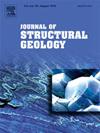青藏高原东部龙日坝断裂运动的时间约束
IF 2.9
2区 地球科学
Q2 GEOSCIENCES, MULTIDISCIPLINARY
引用次数: 0
摘要
青藏高原东部活动断裂构造的时空演化有助于约束该地区的构造和地形历史。在本研究中,我们重点研究了位于高原内部龙门山冲断带(LTB)以西约170 km的龙日坝断裂(LRF)的构造演化。越来越多的地质和地球物理证据表明,LRF是一个突出的右旋走滑断层,具有较小的逆冲成分,是东东隆起内重要的构造和地形边界。根据3对白云母/黑云母40Ar/39Ar年龄,LRF变形的基底岩石在~ 156 ~ 136ma之间经历了快速冷却,而断层断层泥的4对伊立石K-Ar年龄(~ 37.8 ~ 35.6 Ma)表明断层活化过程中矿物生长。这些结果与区域年代学相结合,记录了自晚三叠世古特提斯关闭以来的几个热构造阶段。发现了早白垩世降温事件,反映了南部拉萨-羌塘碰撞引起的边界断裂再活化和地壳增厚。~ 38 Ma的伊利石K-Ar年龄与印度-亚洲“硬”碰撞同步,表明断层扩展到ETP内部。本研究认为,板块辐合的远场效应可能强烈地控制了断层在东太平洋地震带内的运动、再激活和传播,并触发了若干次冷却脉冲。因此,幕式造山可能是由于断层引起的地壳持续增厚和东东隆起所致。本文章由计算机程序翻译,如有差异,请以英文原文为准。
Temporal constraints on the Longriba fault motion, Eastern Tibetan plateau
The spatial and temporal evolution of active fault structures within the eastern Tibetan Plateau (ETP) helps constrain the tectonic and topographic history of that region. In this study, we focus on the tectonic evolution of the Longriba fault (LRF), located ∼170 km west of the Longmenshan thrust belt (LTB) in the interior of the plateau. Increasing geological and geophysical evidence indicates that the LRF, a prominent dextral strike-slip fault with minor thrust components, serves as a significant tectonic and topographic boundary within the ETP. The basement rocks deformed by the LRF experienced rapid cooling between ∼156 and 136 Ma based on three pairs of muscovite/biotite 40Ar/39Ar ages, while four illite K-Ar ages (∼37.8–35.6 Ma) from fault gouges from the fault indicate mineral growth during fault reactivation. These results, combined with regional chronology, document several thermotectonic stages in the ETP since the closure of the Paleo-Tethys in the Late Triassic. An early Cretaceous cooling event was identified, reflecting boundary fault reactivation and crustal thickening, due to the Lhasa-Qiangtang collision to the south. The ∼38 Ma illite K-Ar ages are coeval with the India-Asia ‘hard’ collision, indicating fault propagation into the interior of the ETP. This study concludes that far field effects of plate convergence may strongly control fault movement, reactivation and propagation within the ETP, as well as triggered several pulses of cooling. Therefore, episodic mountain building may be due to continued fault-induced crustal thickening and uplift in the ETP.
求助全文
通过发布文献求助,成功后即可免费获取论文全文。
去求助
来源期刊

Journal of Structural Geology
地学-地球科学综合
CiteScore
6.00
自引率
19.40%
发文量
192
审稿时长
15.7 weeks
期刊介绍:
The Journal of Structural Geology publishes process-oriented investigations about structural geology using appropriate combinations of analog and digital field data, seismic reflection data, satellite-derived data, geometric analysis, kinematic analysis, laboratory experiments, computer visualizations, and analogue or numerical modelling on all scales. Contributions are encouraged to draw perspectives from rheology, rock mechanics, geophysics,metamorphism, sedimentology, petroleum geology, economic geology, geodynamics, planetary geology, tectonics and neotectonics to provide a more powerful understanding of deformation processes and systems. Given the visual nature of the discipline, supplementary materials that portray the data and analysis in 3-D or quasi 3-D manners, including the use of videos, and/or graphical abstracts can significantly strengthen the impact of contributions.
 求助内容:
求助内容: 应助结果提醒方式:
应助结果提醒方式:


